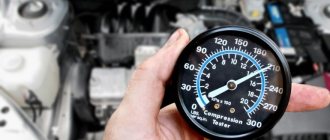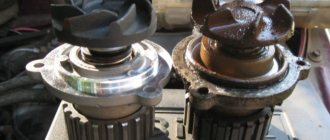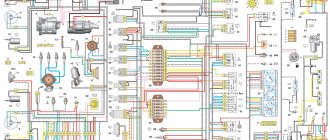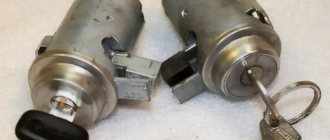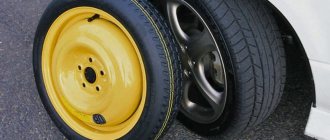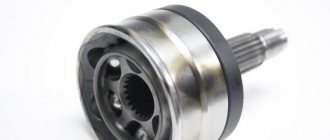Motorists operating VAZ 2121 cars and their modifications are often concerned about the question of what compression should be considered acceptable in a Niva. Such interest is understandable, because it is this indicator that characterizes the degree of wear of the elements of the piston group and the condition of the valves of the gas distribution mechanism. But getting an answer about pressure is only half the battle; then you need to effectively apply this knowledge to clarify faults in case of compression deviations from the norm.
To ensure that the compression test gives accurate results
Compression depends not only on the technical condition of the engine, but also on the conditions under which it is measured. Make sure that during the check:
- the compression gauge was working properly;
- the engine has been warmed up to operating temperature (up to 90 degrees);
- the throttle valve was fully open;
- spark plugs in all cylinders must be turned out;
- the starter was fully operational;
- the battery was fully charged;
- The engine air filter was clean.
Compression and compression ratio are the same thing: the first fairy tale
No not like this! Compression is the pressure in the cylinder, the compression ratio is a dimensionless parameter that describes the geometric parameters of the cylinder: it is the ratio of the total volume of the cylinder to the volume of the compression chamber (the compression chamber is the volume of space above the piston at its position at TDC (it is also called the volume of the end of compression - this is the same thing). Calling it a combustion chamber is incorrect, since fuel combustion occurs throughout the entire volume of the cylinder.) Compression depends on the compression ratio, but the compression ratio does not depend on compression! Compression also depends on a bunch of parameters: compression start pressure, valve timing adjustment, temperature at which the measurement is carried out, leaks from the combustion chamber. And leaks are determined by wear of the rings and cylinders.
“Compression” is the maximum pressure that we measure in the cylinder when the ignition is turned off.
Reasons why there is no compression in the cylinder
Poor (small) compression in one or all cylinders indicates engine wear. There is an old and simple way to determine why compression has disappeared. You need to pour a tablespoon of engine oil into the spark plug hole and repeat the measurements:
- if the pressure has increased noticeably, it means the piston rings have poor sealing;
- if the pressure has not changed, then there may be several reasons (for example, leaking valves, broken gaskets under the cylinder head, there is a crack or burnout in the walls of the combustion chamber, in the piston bottom).
There is another, more accurate way to find out why compression has disappeared. To do this, you will need to modify the spark plug. We remove the insulator from it, and weld the valve of the car camera to the metal body.
Next, set the cylinder piston to the ignition timing position, remove the radiator caps and oil filler neck, screw in the manufactured adapter and pump air into the cylinder using a pump (create pressure in it):
- if air enters the exhaust pipe, it means the exhaust valve is poorly sealed;
- If air goes into the intake manifold, there is a problem with the intake valve.
- if bubbles appear in the expansion tank, then check the cylinder head gasket;
- If there is a hissing sound in the oil filler neck, it means that the piston rings are not properly sealed.
Engine diagnostics using compression measurements in the cylinders allows you to quickly and accurately determine its condition without disassembling, and in some cases will help avoid major repairs of the power unit. Have you ever experienced a lack of pressure in the cylinders? What was the cause of the malfunction? If engine problems persist, check the fuel rail pressure.
Keywords: Lada Granta engine | Lada Kalina engine | Lada Kalina 2 engine | Lada Priora engine | Lada Largus engine | Niva engine | Lada Vesta engine | lada xray engine | universal article
00Found an error? Select it and press Ctrl Enter..
Chevrolet car repair manuals and tips
An engine compression test is performed to find faults in an internal combustion engine. Compression is the compression of the mixture in the cylinder under the influence of external forces. Compression is measured as the compression ratio multiplied by 1.3. When measuring compression, you can find a cylinder that is malfunctioning.
If the car has various kinds of problems, such as a drop in power, oil loss, or tripping in the engine, then check the spark plugs, sensors, and inspect the engine for damage and leaks. When such checks do not bring results, they resort to compression measurements.
You can check the compression yourself using a compression gauge. At service stations, such checks are done using a compressor or motor tester.
Engine compression can decrease for many reasons:
1. Wear of pistons and piston group parts 2. Incorrect timing adjustment 3. Burnout of valves and pistons.
To specifically determine the cause of the malfunction and measure engine compression. Let's figure out how to carry out this procedure.
Checking engine compression
First you need to prepare the engine for testing. To do this, we first need to warm up the engine to a high temperature of 70-90 degrees. After this, you need to turn off the fuel pump so that no fuel is supplied and remove the spark plugs.
Be sure to check the functionality of the starter and battery charging. The last step in preparation is to open the throttle and air valve.
After all this, we move directly to checking the compression:
1. Insert the tip of the compression gauge into the spark plug connector and use the starter to crank the engine until the pressure stops increasing. 2. The crankshaft should rotate at about 200 rpm. 3. If the engine is working properly, the compression should increase in a matter of seconds. If this happens for a long time, this is evidence of burnt out piston rings, if the pressure does not increase at all, then most likely the block gasket needs to be changed. Should the minimum pressure in a gasoline engine be 10 kg/cm? (in a diesel engine more than 20 kg/cm?). 4. After taking the readings, release the pressure by unscrewing the cap on the device. 5. Check all other cylinders in the same way.
There is another method of checking, which differs from the above in that engine oil is poured into the cylinder being tested. An increase in pressure indicates worn piston rings; if the pressure does not increase, then the reason is the cylinder head gasket, or there is a leak in the valves.
If the engine is in good working order, the compression in it should be from 9.5 to 10 atmospheres (gasoline engine), while in the cylinders it should differ by no more than an atmosphere.
You can also diagnose weak compression by the operation of the carburetor. If there is an air leak, check the fit of the bypass valve. If air leaks out of the top of the radiator, then a faulty cylinder head is to blame.
What affects engine compression
1. Throttle position. When the throttle is closed or covered, the pressure decreases 2. Air filter contamination 3. Incorrect valve timing when the valve closes and opens at the wrong moments. This happens when the belt or chain is installed incorrectly 4. The valves are not closed on time due to gaps in their drive. 5. Motor temperature. The higher its temperature, the higher the temperature of the mixture. Therefore, the pressure is lower. 6. Air leakage. Air leaks reduce compression. They are caused by damage or natural wear of the combustion chamber seals. 7. Oil entering the combustion chamber increases compression 8. If fuel enters in the form of drops, the compression decreases - the oil, which plays the role of a seal, is washed off 9. Lack of tightness in the compression gauge or in the check valve 10. Crankshaft rotation speed. The higher it is, the higher the compression, there will be no leaks due to leaks
The above describes how to measure compression in an internal combustion engine running on gasoline. In the case of a diesel engine, measurements are made differently.
Measuring compression in a diesel engine
1. In order to turn off the flow of diesel into the engine, you need to disconnect the fuel supply valve from the power supply. This can also be done by clamping the shut-off lever on the high pressure pump. 2. Measurements on a diesel engine are made with a special compression meter, which has its own characteristics. 3. When checking, you do not need to press the gas pedal, since such internal combustion engines do not have a throttle. If there is one, it must be cleaned before checking. 4. Each type of engine is provided with special instructions on how to measure compression on it.
It is worth remembering that compression measurements may not be accurate. For the most part, measurements need to take into account the pressure difference between the cylinders, and not the average compression value.
You should definitely take into account such parameters as oil, engine, air temperature, engine rotation speed, etc. Only taking into account all the parameters can one draw a conclusion about the degree of wear of the pistons and other parts that affect compression. And as a result of all these malfunctions, give a conclusion about the need for a major overhaul of the engine.
Source: chevymanual.ru
Taking a measurement
Measurements of the compression value are carried out in each cylinder separately, and the power unit must be in a warm state. In a cold engine, the readings will be lower than actual ones, although in the presence of a glaring malfunction they will also be able to reflect the picture. To measure you will need the following tools and devices:
- spark plug key;
- a pressure gauge (otherwise known as a compression gauge) of a threaded or clamping type;
- rags.
A pressure compression gauge is a steel tube with a handle, at one end of which a rubber cone and valve are installed, and a pressure gauge is screwed to the other.
The device is inserted with a rubber cone into the threaded part of the cylinder and pressed using the handle. In this case, you cannot do without the services of an assistant who turns on the starter.
A pressure gauge with a hose and a thread at the end will have to be screwed into each hole one by one, but you can check it yourself. The procedure for performing measurements is as follows:
- Remove the high-voltage wires from the spark plugs and move them as far away as possible to avoid electric shock.
- Unscrew all spark plugs and wipe their seats with a rag. It is advisable to arrange them in the order of unscrewing, so that during diagnostics you can determine which cylinder the spark plug was removed from.
- Insert or screw the end of the device into the hole of cylinder 1 and turn on the starter for 3-6 seconds.
- Record the readings and move on to the next cylinder.
If for some reason the measurement did not work or you held the compression meter askew, the procedure must be repeated. Take your time to clean the spark plugs; their condition can tell a lot during the test analysis.
Why do you need to check?
It is recommended to measure compression at least once every 15-20 thousand kilometers. Its deviation to a lesser extent leads to the fact that the fuel mixture is not compressed to the required level and ignites at a slower rate, as a result of which the engine overheats and its power is significantly reduced.
Also interesting: How to change the engine oil on a Niva
Increased compression, on the contrary, causes early ignition of the mixture, as a result of which it detonates, creating additional loads on the piston elements.
If there is a difference in compression in the cylinders of one engine, the mixture will ignite at different rates, creating an imbalance in the coordinated operation of the pistons and camshaft(s).
Communities › Kulibin Club › Blog › 100 horses in Niva - for real! Increased efficiency
I thought for a long time about where to start the topic, it would probably be more correct to first write how I came to this. I was constantly tormented by the question - why does a car consume on average 10 liters of fuel, and a Niva - 15 liters? Why is the efficiency of an internal combustion engine so low? How can it be increased?
I liked physics since school; the Internet opened access to many materials and technical literature.
I’ll tell you the result of 8 years of work - 7 modified engines of different models. Engines modified using my method become 20-30% more powerful, while at the same time fuel consumption decreases by 10-20%. Efficiency increased - FACT.
Refinement work is carried out during an engine overhaul and, with the right approach to repairs, does not increase its cost at all. Intercapital mileage increases by 50 - 100 thousand km. There is a justification. I will write about everything in detail, since I have a lot of work to do.
Instructions for checking compression of VAZ-2109
To measure compression, you need to prepare special tools:
- a compression gauge consisting of a soft bendable hose, a pressure release key and a tip with a measurement panel;
- spark plug key.
When diagnosing yourself, you cannot do without an assistant. Instructions for measuring compression of a VAZ-2109 injector and carburetor look like this:
- Turn on the car engine and heat it to a temperature of 80 to 90 degrees.
- Remove the hose from the fuel pump that drains gasoline.
- Carefully unscrew the spark plugs, first clearing the wells of any build-up of dirt and debris.
- Remove the armor wire located in the center from the toggle switch cover, fix the spark plug in it and place it on top of the engine.
- Place the compressor tip in the recess of the first cylinder; the device does not have to be screwed in; it can be pressed against the hole with your hands.
- Proceed to measure pressure. The assistant must take the driver's seat and press the gas pedal all the way, then turn the key in the ignition and start the starter for at least 3-5 seconds.
- Watch how the compression meter values change at this time, the dynamics of increasing readings should be recorded, and also write down the maximum position of the arrow. Once locking is complete, release the pressure by pressing the release button.
- These actions must be performed for each engine cylinder separately, so as not to forget the indicators, record them on a piece of paper.
Fixing problems
In most cases, when the friction parts of the engine wear out, the pressure drops, although there is a malfunction in which the compression, on the contrary, increases. It is necessary to consider possible breakdowns in order, starting with the causes of low pressure:
- The piston rings are worn. Average engine oil consumption is observed (up to 300 g per 1000 km), and compression is uniformly reduced in all cylinders. To verify this, you can dump 5-7 g of oil inside, crank the crankshaft using the starter and repeat the measurement. If the pressure increases sharply by 2-3 bar, then the problem lies in the rings.
- I developed my resource for the entire piston group. Oil consumption is high. from 300 to 500 g per 1000 km, from the exhaust pipe. gray smoke, and on the candles. oil deposit. When the pressure is re-measured with the addition of oil, the index does not increase because the gaps between the walls of the engine friction parts are too large.
- The valves are poorly adjusted, in the jargon. jammed. If there is no gap between the tappet and the camshaft neck when cold, then when it heats up, the latter expands and opens the channel, it remains open. Because of this, compression can drop to zero and the cylinder does not work.
- The valves may be slightly open due to accumulated deposits on the pressure side. Then the pressure can also drop significantly. Typically, this situation is the result of oil entering the combustion chamber through worn rings. That is, when the cylinder head is removed, a complex fault occurs.
Sometimes in Niva cars, compression may disappear in 4 cylinders and noticeably decrease by 3: this is the result of engine overheating.
The fourth piston, as well as the furthest one from the cooling fan, significantly expanded and damaged the cylinder walls (burnt in the slang). The same thing happens with 3 pistons, although to a lesser extent.
Also interesting: How much oil is in a Chevrolet Niva engine
The engine runs poorly and smokes, oil consumption. up to 1 liter per 1000 km. Urgent need for major repairs.
If you measure compression...
If you measure the compression... Taken from https://kompressometr.ru Until recently, the engine worked like a clock, but the power dropped, fuel and oil consumption increased. At idle, vibration became noticeable - the engine was clearly “troubling”, i.e. one of the cylinders is not working properly. And if replacing the spark plugs does not change anything, in such cases, to determine the cause of the malfunction, they often resort to measuring compression - one of the simplest and most accessible diagnostic methods. Compression is the amount of maximum pressure in the cylinder created when the engine is idling with the starter (for example, when the spark plug is turned off). To measure compression, you need to install a compression gauge instead of a spark plug. This device is a pressure gauge connected by a hose to a fitting and a check valve. As the engine crankshaft rotates, air is forced into the hose until the pressure in the hose equals the maximum pressure in the cylinder. Its value will be recorded by a pressure gauge. The apparent simplicity and accessibility have earned the compression gauge the reputation of being a kind of “universal” device, capable of not only identifying a malfunction, but also generally assessing the technical condition of the engine as a whole. Unfortunately, this universality is deceptive - the obtained measurement results often require special analysis, and it is not always correct to draw unambiguous conclusions from them. Here are just two examples of this. A relatively new engine cannot be started. Compression in the cylinders is 0.5-0.6 MPa (5-6 kg/cm2), which is approximately half the norm. The reasons may be mechanical failure or wear of parts of the cylinder-piston group. But the same drop in compression will be observed if, due to a malfunction of the control system, excess fuel enters the cylinders. It washed away the oil from the cylinder walls, and the piston rings no longer properly sealed the cavity of the combustion chamber. Another case: with an old engine, the measured compression is 1.1-1.2 MPa. Norm! However, the engine consumes more than 1 liter of oil per 1000 km. This is understandable if you take into account the wear of rings, pistons and cylinders. What's the matter? Yes, just a large amount of oil penetrating into the combustion chamber well seals the gaps between worn parts. As we can see, the measurement results should be treated with caution. And in order not to make mistakes in your conclusions during repairs, you should know in which cases you can confidently rely on the measurement results, and when you can only take note.
When the piston moves from the bottom dead center (a), the pressure begins to increase only after the intake valve closes (b) and reaches a maximum at the top dead center (c): h - piston movement, at which the pressure in the cylinder does not increase. What affects compression? Theoretically, the maximum cylinder pressure at the end of the compression stroke, when the piston is at top dead center (TDC), depends on a number of factors. From the point of view of repair practice, they ultimately affect the amount of air entering the cylinder - the larger it is, the higher the compression. First of all, let's note the position of the throttle valve - covering it or closing it will obviously greatly reduce the pressure in the cylinder. The amount of air is understandably affected by the degree of contamination of the air filter. Some mechanics make mistakes in setting the valve timing, for example, when installing the camshaft drive belt or chain. This leads to a change in the closing moment of the intake valve, shifting the beginning of compression in the cylinder to one side or the other. Then the compression values will be different. The clearances in the valve drive have a significant effect on compression. Thus, a small gap in the intake valve drive will lead to their closing later and, accordingly, to a decrease in compression. At the same time, small clearances in the exhaust valves will increase the so-called valve overlap - the amount of crankshaft rotation angle during which both valves in the cylinder are open simultaneously. The result is the same - compression will decrease. The engine temperature will also affect compression - the lower it is, the more the air compressed in the cylinder will be cooled, and the lower its pressure will be. By the way, the clearances in the valve drive will also “monitor” the temperature - the lower it is, the smaller the clearances and compression. But that's not all. As soon as the air in the cylinder is sufficiently compressed, various types of leakage will begin to appear through the gaps between worn or damaged parts sealing the cavity of the combustion chamber. Naturally, from the above, it follows that leaks will be minimal if the cylinder has a perfectly round shape, there are no longitudinal marks on its working surface, the piston rings fit perfectly to it and to the end surfaces of the piston grooves; if the gaps in the ring locks are close to zero and, finally, the valve plates fit perfectly to the seats. But we all know that nothing is perfect in nature. There are always some leaks, even with a new engine. The only question is how big they are. Therefore, let us recall the factors that, to one degree or another, influence the intensity of air leaks, and, consequently, compression:
- - first of all, let's point out the engine temperature - as it rises, it increases the compression, since the parts fit better together, taking on dimensions and relative positions that are more suitable for the workers; — then we recall that the oil entering the combustion chamber through the valve guides, piston rings, crankcase ventilation system and turbocharger seals significantly increases compression, as it has a sealing effect; - fuel entering the cylinder in the form of drops, on the contrary, reduces compression, as it dilutes and washes away the oil from the parts and does not have a sealing effect due to its low viscosity; — leakage of the check valve or compression gauge hose, as well as the high force of the check valve spring, have the same effect; - and, finally, the higher the crankshaft speed, the less leakage through leaks, the higher the compression.
What does low compression lead to?
Most often, compression in the cylinders does not increase, but decreases. This may be a consequence:
- wear or damage to compression rings;
- wear or burnout of valves;
- damage to the cylinder head gasket;
- cracks in the cylinder head.
These problems can cause:
- reducing engine power;
- deterioration of dynamic performance;
- increased fuel consumption;
- “forcing” oil into the air filter housing (in carburetor engines);
- oil getting inside the combustion chambers (the engine “eats” oil, which is characterized by bluish exhaust smoke).
If you find the listed signs in your car, be prepared to at least replace the piston and, at maximum, overhaul the engine. But before you start repairing it, you should make sure that the compression is really low.
Tuning
The manufacturer used only one technique to increase engine power - increasing the piston stroke. Self-tuning will help you modify the 21214 engine to use its full potential (about 90 hp):
- boring of cylinders in the block - scheme 84/84 or 84/88 to obtain 1.9 liters and 2.0 liters (cylinder diameter/piston stroke, respectively);
- modification of the cylinder head - boring of channels up to 31 mm (exhaust) and 33 mm (intake), installation of a lightweight SHPG flywheel, Nuzhdin camshaft.
Thus, the injection version 21214 is superior to the basic modification of the carburetor engine. It has increased torque and power, and bends the valves with pistons when the single-row chain wears out.
How else to determine the reduced pressure in the engine cylinders
If you have regular motor oil on hand, you can easily check the low compression on the VAZ-2109 by following this guide:
- Add 10 cubes of oil to the cylinder and measure the pressure again.
- If the readings of the measuring device have increased, the problems consist of rings that are stuck and wear of the cylinder-piston set.
- If the compression meter values remain at the same level, it means that the valve has burned out or the gasket adjacent to the cylinder head has been damaged.
Maintenance
The manufacturer AvtoVAZ recommends servicing the 21214 engine on your own or at a service station according to the following schedule:
- the oil and filter are updated annually or after 7.5 - 10 thousand mileage;
- the chain has a high resource of 200 thousand, but is regularly monitored for stretching/tension;
- the fuel and air filters become unusable after 20 - 30 thousand mileage;
- spark plugs and batteries are usually enough for 60 - 70 thousand km;
- It is recommended to update the cabin filter annually, regardless of the car's mileage.
Initially, the internal combustion engine design was simpler, but it was necessary to periodically adjust the erroneous settings of the valve thermal clearances. Then the modernization added hydraulic pushers to the timing belt design, saving the user from this operation and monthly expenses.
How to get rid of stuck piston rings
If the fault is that the rings are stuck, to repair them, repeat the following steps:
- Warm up the VAZ-2109 engine.
- Find a spark plug hole in each cylinder and add 10 cm cubes there using a medical syringe or rubber bulb. a mass consisting of kerosene (occupies half of the total mass), acetone (a quarter of the volume), motor oil (a quarter of the volume).
- Set the mixture aside for 3-4 hours; if you have time and there is no hurry, it is better to leave it overnight.
- After this, rotate the starter for 10-15 seconds with the spark plugs turned out.
- All that remains is to drain the old oil, and after replacing the old filtration device, fill in the new one.
Now that you know what engine cylinder compression should be on a VAZ-2109 and how to determine it yourself, and most importantly, how to eliminate the detected faults, returning the car is not difficult.
How to get rid of inaccurate compression measurements
The compression meter may show inaccurate values if at least one of the following factors exists:
- VVAZ-2109 battery is practically not charged;
- a starter malfunction has been detected;
- the engine is cold;
- valve clearances do not correspond to normal values;
- gasoline got into the cylinders;
- The measurements were initially taken incorrectly.
In the absence of an assistant, the procedure was carried out without pressing the gas pedal, which in itself is considered a significant violation of pressure measurement.
Experts note that the compression meter gives increased readings when there is excess oil in the cylinders, this is due to wear of the oil scraper caps built to guide the VAZ-2109 or CPG valve bushings.
Regardless of which mechanism is installed in the VAZ-2109 - a carburetor or an injector - the maximum pressure value is calculated based on the product of the compression ratio and a constant coefficient equal to 1.2.
How to check it yourself
Having a compression gauge and an assistant at hand, measuring compression will not be difficult.
- Warm up the engine to operating temperature.
- Shut off the fuel supply to the cylinders. For carburetor engines, disconnect the hose that goes from the carburetor to the fuel pump; for injection engines, remove the fuel pump fuse and let the engine run until the fuel is used up from the system.
- Disconnect all high voltage wires from the spark plugs.
- Unscrew the first spark plug and insert the compression gauge fitting in its place.
- Have a helper run the starter for a few seconds until the pressure gauge needle stops moving up.
- Take pressure gauge readings and compare them with standard values.
- Carry out the same procedure for all cylinders. Compare the compression ratios in the cylinders.
What are the cylinder compression standards for VAZ engines?
Engine specifications must indicate “minimum cylinder compression values.” If you cannot find such data, determine the compression standards yourself using the formula:
| Compression (kgf/cm2) = compression ratio (see technical specifications of internal combustion engine) * coefficient (for VAZ min 1.2, max 1.3) |
A few examples:
- The compression ratio of modern VAZ 21126 and VAZ 21127 engines installed on Granta, Kalina and Priora is 11. We multiply the values using the formula and get the compression standards: 13.2..14.3.
- For the Vesta engine (VAZ-21129) the compression ratio is 10.45, the compression standards will be: 12.5..13.6.
- For Niva (VAZ 21213, 21314) - 11.3..12.2.
Also interesting: Niva engines
If the compression gauge values in all cylinders are within the normal range, this does not mean that everything is fine. Different compression in the cylinders is also bad. It is important that the difference between all readings is minimal. Compare the minimum and maximum compression values in the cylinders. According to technical standards, the difference should be no more than 1 kgf/cm2 or 10%.
Characteristics of motor 21214
It is believed that the basis of the ICE 21214 was the previous version 21213. In fact, ¾ of the parts in the engine
- the engine layout has changed - an injector instead of a carburetor;
- additional attachments appeared - DPKV, DXX sensor, Bosch MP 7.0 controller;
- crankshaft with a long crank radius of 40 mm, not used in previous AvtoVAZ engines;
- Cylinder head with holes for phase sensor and receiver studs, hydraulic supports for valve levers instead of adjusting bolts.
Since the base model bends the valve, the 21214 engine did not escape this fate, so the manual includes not only a description of the engines, but also maintenance regulations in order to ensure at least the minimum declared service life of 80,000 km, which was promised by the manufacturer’s representatives.
The design of the power drive 21214 provides it with the following technical characteristics:
combined cycle 10.5 l/100 km
city – 11.5 l/100 km
real 160000 km
flywheel – 62 – 87 Nm
clutch bolt – 19 – 30 Nm
bearing cap – 68 – 84 Nm (main) and 43 – 53 (rod)
cylinder head – three stages 20 Nm, 69 – 85 Nm + 90° + 90°
With the advent of hydraulic thermal valve lash compensators, it is recommended to use exclusively high-quality engine oil.
What should the compression be in VAZ cars?
The average compression rate for unboosted VAZ engines is 8-9 atmospheres, for forced ones with a reduced combustion chamber - 11-13 atmospheres.
In order to accurately determine the standard compression ratio, use the table that indicates the compression ratio in the cylinders of eight- and sixteen-valve VAZ engines.
| Number of valves | 16 | 16 | 8 | |
| Engine volume, l | 1,5 | 1,6 | 1,5 | 1,6 |
| Cylinder diameter/piston stroke, mm | 82/71 | 82/75,6 | 82/71 | 82/75,6 |
| Compression ratio | 10,5 | 10,3 | 9,9 | 9,6 |
Modifications
Since 1994, the manufacturer has adjusted the parameters of motor 21214 several times:
- 21214-10 (2002) – Euro-0, the first version had central gasoline injection;
- 21214-20 (2006) – Euro-2 controller Bosch MP 7.0, pairwise variable injection;
- 21214-30 (2008) – Euro-3, without power steering;
- 21214-41 (2011) – Euro-4 for the Russian Federation and Euro-5 for export, power steering, welded manifold;
- 21214-22 – Euro-2, hydraulic supports for valve levers appeared;
- 21214-31 – Euro-3, welded steel manifold, power steering pump;
- 21214-32 – Euro-3, power steering, cast iron manifold, flywheel for 215 mm clutch diameter;
- 21214-33 – Euro-3, cast iron manifold, hydraulic booster;
- 21214-34 – Euro-3, cast manifold without power steering.
All versions from the factory had INA hydraulic mounts, with the exception of version 21214-41, which was equipped with YAZTA hydraulic mounts.
Modification 21214-28 had a volume of 1.8 liters due to the larger piston stroke of 84 mm. The engine power reached 92 hp. s., and the torque is 159 Nm. In total, a little more than 69 engines of this type were produced.
Troubleshooting
In most cases, when the rubbing parts of the engine wear out, the pressure decreases, although there is a malfunction in which the compression, on the contrary, increases. It is necessary to consider possible breakdowns in order, starting from the causes of low pressure:
- The piston rings are worn out. Average engine oil consumption is observed (up to 300 g per 1000 km), and compression decreases evenly in all cylinders. To verify this, you can drop 5-7 g of oil inside, crank the crankshaft with the starter and repeat the measurement. If the pressure increases sharply by 2-3 bar, then the problem is in the rings.
- The entire piston group has exhausted its service life. Oil consumption is high - from 300 to 500 g per 1000 km, blue smoke is noticeable from the exhaust pipe, and oil deposits are present on the spark plugs. When the pressure is measured again with the addition of oil, the indicator does not increase, since the gaps between the walls of the rubbing parts of the engine are too large.
- The valves are poorly adjusted, in the jargon they are clamped. If there is no gap between the valve tappet and the camshaft journal when cold, then when heated, the latter expands and opens the channel slightly, it remains constantly open. Because of this, compression may drop to zero and the cylinder will fail.
- The valves may be slightly open due to accumulated carbon deposits on the working part. Then the pressure can also drop significantly. Typically, this situation is the result of oil entering the combustion chamber through worn rings. That is, the malfunction is complex and is detected when the cylinder head is removed.
Sometimes in Niva cars, compression can disappear in cylinder 4 and decrease noticeably in cylinder 3: this is the result of engine overheating.
The fourth piston, being the farthest from the cooling fan, expanded greatly and damaged the cylinder walls (in jargon, it burned out). The same thing happens with piston 3, although to a lesser extent.
The engine runs poorly and smokes, oil consumption is up to 1 liter per 1000 km. Major repairs are urgently needed.
And it’s not a fairy tale at all.
So what does compression do? For a lot! The main thing is the starting properties of the motor, especially at low temperatures.
This primarily applies to diesel engines, where the pressure and temperature at the end of compression determine whether the fuel in the cylinder will ignite or not. But gasoline engines in a cold state are also sensitive to changes in compression: it affects the volatility of the fuel, which, during a cold start, should only theoretically evaporate on the way to the cylinder. But in reality, it gets there in the form of non-flammable liquid drops.
Reduced compression increases crankcase gas pressure. In this case, a larger volume of oil vapor flies through the ventilation system to the engine inlet. This is bad: toxicity increases, and the rate of combustion chamber contamination increases sharply.
Uneven compression across the cylinders causes engine vibrations, especially noticeable at idle and at low speeds. And this, in turn, harms both the transmission and the engine suspension. And to the driver himself.
In short, the role of compression as a diagnostic sign, largely characterizing the condition of the engine, is very great. And our “fairy tales” in no way call for giving up on her - on the contrary! But the desire for an unbridled increase in it in search of additional “horses” is generally futile.
Reasons for low pressure in the cylinders of the VAZ-2109 engine
Air compression will show why the pressure is low. To determine the compression stroke in a specific cylindrical device, place a thin and long screwdriver in the spark plug hole; you can replace it with a regular stick or a piece of wire. Hold the screwdriver with your hand and lower it directly onto the piston bottom.
When the air is compressed, the screwdriver comes out of the spark plug hole, following the direction from bottom to top. Your task is to determine the moment when the upward movement stops and changes into a downward movement following the piston; this is the intake stroke - the starting point of the piston movement and the end of the compression stroke.
Next, insert the hose coming from the compressor into the recess of the spark plug and transfer the air flow into the cylindrical structure, pumping up pressure from 2 to 3 atmospheres. The malfunction of the unit is determined by where the air comes from:
- If air leaks through the adjacent recess into the spark plugs or appears in the expansion tank, it means the head gasket has burned out.
- If the air flow comes out of the carburetor, the intake valve may be burnt out, and there is also the possibility of poor valve adjustment.
- Air coming out of the muffler also indicates a burnt out exhaust valve or poor regulation.
- If the air flow is directed from the breather, it can be assumed that the rings and pistons are worn.
How to measure compression in cylinders
A device for checking compression in cylinders is called a compression gauge. There are many varieties of them, but the differences between them are only constructive. Great for self-diagnosis.
At service stations you can find more complex devices that use a recorder instead of a dial pressure gauge that records the compression on a form or display.
Read news about the new Niva
- knocking in suspension @ Niva 4×4
- Tuning Niva 2121 with your own hands (photo video)
- Niva Chevrolet speed sensor - Auto magazine MyDucato
- Technical characteristics (3-door, 5-door and Urban)
- Niva tuning: 145 photos of ideas on how to improve the VAZ 2121 with your own hands
- Change of oil. VAZ 21213, 21214 (Niva)
- Review of summer tires Cordiant Off Road (Cordiant Off Road): owner reviews, price comparison, sizes, characteristics, functions and features
- Mini jeeps or small SUVs are becoming less popular
